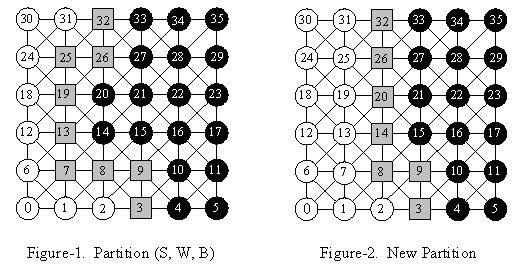|
Time Limit: 1000MS |
Memory Limit: 30000K |
|
|
Total Submissions: 2547 |
Accepted: 786 |
Description
In this problem, we consider the separators in grids. Each node in a grid is connected to its eight neighbors (if they exist). In Figure-1, we illustrate a partition of a 6*6 grid with a 9-point separator (gray nodes in the figure). The nodes on the left of the separator are in set W (white nodes), and the nodes on the right of the separator are in set B (black nodes).

To simplify the problem, you can assume that all the separators referred in this problem satisfy the following restrictions:
1) It’s a minimal separator. A separator is minimal if no subset of it forms a separator.
2) It begins from a node on the top line of the grid, except the corner (i.e. 30 and 35 in the figures), and ends with a node on the bottom line of the grid, also except the corner (i.e. 0 and 5 in the figures).
3) On its way from top to bottom, it can go left, right or down, but never go up.
Now we describe a method to improve a given partition on a grid, through which we can reduce the number of nodes in the separator. This method contains two steps:
1) Select several nodes from B and add them into S. Any of the selected nodes must have a left neighbor which is in S.
2) Remove several nodes from S (excluding the nodes added in the former step), and add them into W.
After the improvement, we should ensure S is still a separator, and make the number of nodes in S as small as possible. As for Figure-1, we should add 14 and 20 into S, and remove 7, 13, 19 and 25 from S. After that, we obtain a new partition with a 7-point separator shown in Figure-2.
Your task is, given a partition on a grid, to determine the least number of nodes in the separator after the improvement.
Input
A test case of N = 0 and M = 0 indicates the end of input, and should not be processed.
Output
Sample Input
6 6 WWSBBB WSSBBB WSBBBB WSBBBB WSSSBB WWWSBB 0 0
Sample Output
7
Source
#include <cstdio>
#include <cmath>
#include <algorithm>
#include <iostream>
#include <cstring>
#include <map>
#include <string>
#include <stack>
#include <cctype>
#include <vector>
#include <queue>
#include <set>
#include <iomanip>
using namespace std;
//#define Online_Judge
#define outstars cout << "***********************" << endl;
#define clr(a,b) memset(a,b,sizeof(a))
#define lson l , mid , rt << 1
#define rson mid + 1 , r , rt << 1|1
#define FOR(i , x , n) for(int i = (x) ; i < (n) ; i++)
#define FORR(i , x , n) for(int i = (x) ; i <= (n) ; i++)
#define REP(i , x , n) for(int i = (x) ; i > (n) ; i--)
#define REPP(i ,x , n) for(int i = (x) ; i >= (n) ; i--)
#define mid ((l + r) >> 1)
#define mk make_pair
const int MAXN = 200 + 10;
const int maxw = 10000000 + 20;
const int MAXNNODE = 10000 +10;
const long long LLMAX = 0x7fffffffffffffffLL;
const long long LLMIN = 0x8000000000000000LL;
const int INF = 0x7fffffff;
const int IMIN = 0x80000000;
#define eps 1e-8
#define mod 10007
typedef long long LL;
const double PI = acos(-1.0);
typedef double D;
typedef pair<int , int> pii;
struct point
{
int x , y ;
point(){}
point(int y , int x):y(y) , x(x){}
};
int n, m[MAXN][MAXN] , vis[MAXN][MAXN];///m记录图形,vis记录S的数量
int M , d[3][2] = {{-1 , 0} , {1 , 0} , {0 , 1}};
int bfs(int i)
{
queue <point> q;
point tmp(1 , i);
q.push(tmp);
vis[1][i] = 1;
while(q.size())
{
point u = q.front();
q.pop();
FOR(k , 0 , 3)
{
tmp.x = u.x + d[k][0];
tmp.y = u.y + d[k][1];
if(tmp.x > M||tmp.x <1)continue;
if(tmp.y > n||tmp.y < 1)continue;
if(vis[tmp.y][tmp.x]||!m[tmp.y][tmp.x])continue;
vis[tmp.y][tmp.x] = vis[u.y][u.x] + 1;
if(tmp.y == n)return vis[tmp.y][tmp.x];
q.push(tmp);
}
}
}
int main()
{
//ios::sync_with_stdio(false);
#ifdef Online_Judge
freopen("in.txt","r",stdin);
freopen("out.txt","w",stdout);
#endif // Online_Judge
while(~scanf("%d%d" , &n , &M) , M||n)
{
char ch;
clr(m , 0);
REPP(i , n , 1)FORR(j , 1 ,M)
{
while((ch = getchar())!='W'&&ch != 'S' && ch != 'B');
if(ch == 'S')
{
m[i][j] = 1;
if((i == 1||i == n)&&j < M - 1)m[i][j + 1] = 1;
else if(i > 1 && i < n && j < M)m[i][j + 1] = 1;
}
}
int ans = INF;
FORR(i , 1 , M)
{
if(m[1][i])
{
clr(vis , 0);
ans = min(bfs(i) , ans);
}
}
printf("%d\n" , ans);
}
return 0;
}